17+ Sample Dealership Agreements
-
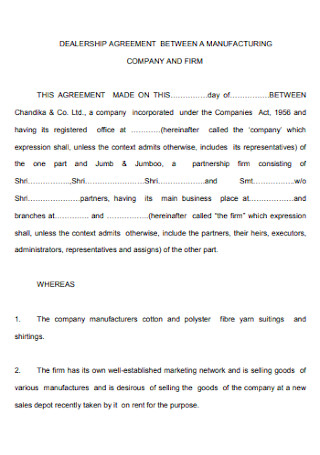
Company Dealership Agreement
download now -
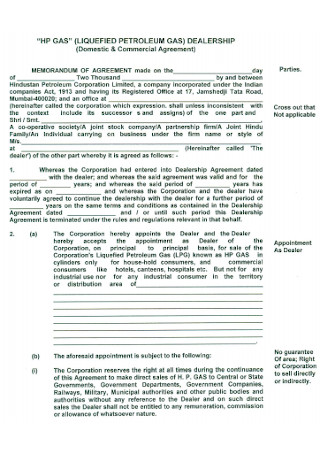
Gas Dealership Agreement
download now -
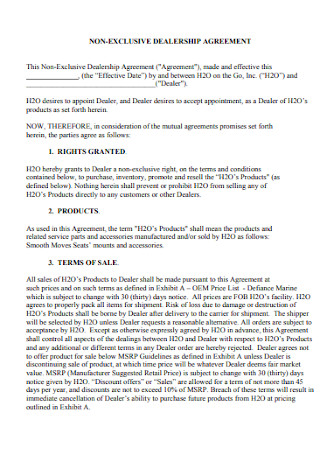
No-Exclusive Dealership Agreement
download now -
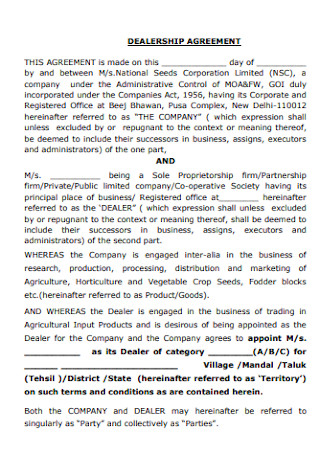
Sample Dealership Agreement
download now -
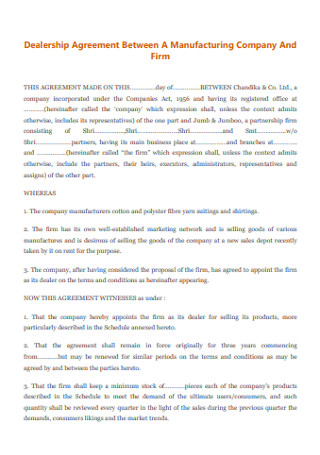
Manufacturing Company Dealership Agreement
download now -

Dealership Agreement Format
download now -
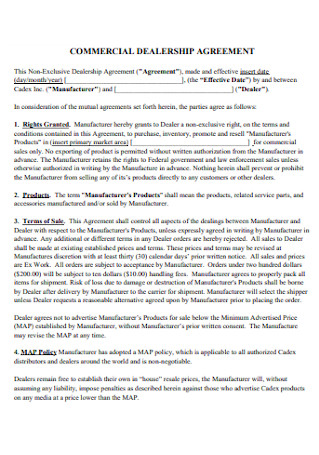
Commercial Dealership Agreement
download now -
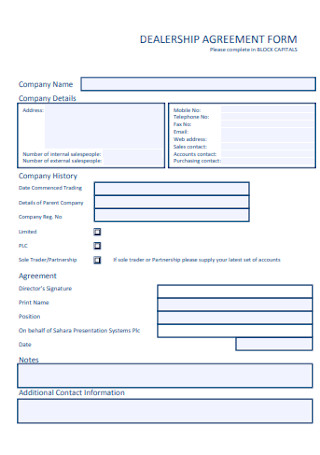
Dealership Agreement Form
download now -
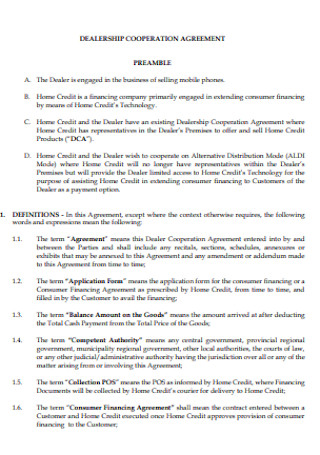
Dealership Corporation Agreement
download now -
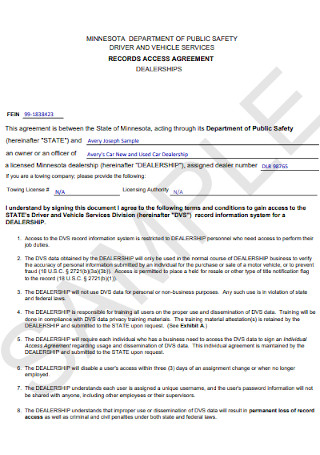
Dealership Access Agreement
download now -
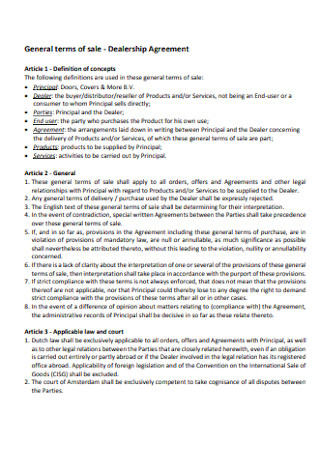
Dealership Sales Agreement
download now -
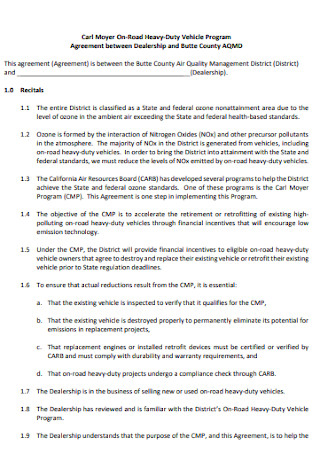
Vehicle Dealership Agreement
download now -
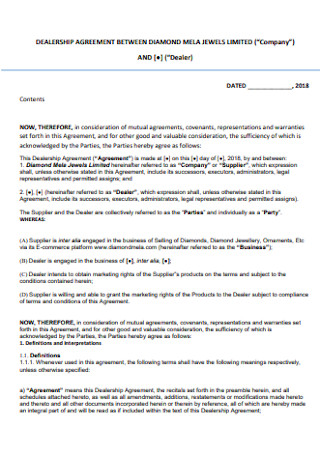
Diamond Jewels Dealership Agreement
download now -

Solar Dealership Agreement
download now -
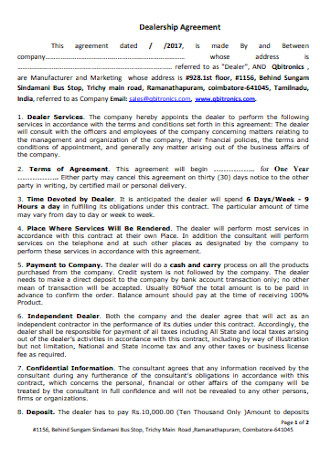
Standard Dealership Agreement
download now -
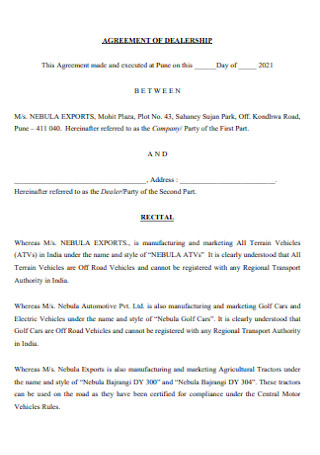
Formal Dealership Agreement
download now -

Simple Dealership Agreement
download now -
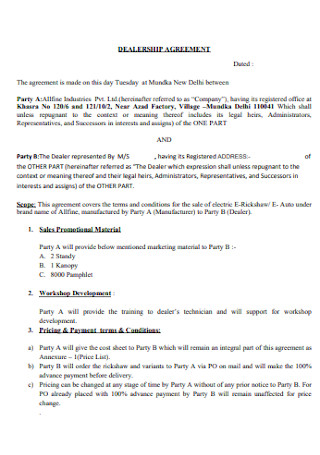
Printable Dealership Agreement
download now
What Is a Dealership Agreement?
A dealership agreement is a legally binding contract outlining the rights and responsibilities of a car manufacturer and a car dealer. A dealer agreement may also control the commercial relationship between a general dealer and a supplier. Depending on the manufacturer and dealers’ scale, these agreements can become increasingly intricate and extensive. A dealership agreement with a more prominent manufacturer may stipulate a dealer’s responsibilities regarding the facilities where the automobiles will be sold, the staff and personnel who will be marketing the cars, and the statements and sales reporting requirements. In recent years, statistics indicate that the profit margin at new-car dealerships has hovered at just about 2 percent. Indeed, it is a low-profit sector. In contrast, businesses such as accountancy, real estate, and dentistry, to name a few, typically enjoy average profit margins more significant than 15 percent.
Types of Distributors
When you want to grow your business, expand into new areas, or reduce the cost of your current distribution plan, it is helpful to be familiar with the many types of distributors and how to utilize them. Consider the following seven sorts of distributors:
Tips for Improving Dealership Profitability
From the outside, it undoubtedly appears highly lucrative. Daily, keys are exchanged, and expensive vehicles are driven off dealership lots. However, those conversant with the retail car industry know that dealership profitability in the current economic context is ephemeral. Consistent with the steady growth of the dealership’s revenues, expenses also increase. Payroll duties and the upkeep of facilities that comply with automakers’ requirements for modern showrooms and customer waiting spaces are costly for dealerships. And whenever a brand-new automobile remains on the lot for more than a few months, it is practically hard to make a profit from the sale of that vehicle. Indeed, the post-recession era has significantly transformed the retail car industry. However, the prosperity of a car dealership does not need to evaporate like the scent of a brand-new automobile leaving the lot. Here are four ideas to increase your dealership’s profitability in the coming quarters and years:
1. Concentrate on Recruiting Top-Notch Talent
Managing people and making money at a dealership go hand in hand. The National Automobile Dealers Association says that 64 people work at the average dealership. When you have the right team, your dealership can take advantage of top salespeople and skilled mechanics who are known for their customer service. On the other hand, if your dealership has many employees leaving, you must keep paying the costs of hiring new people. Create a plan that will help you hire the best people and retain the best ones. Set up a structured hiring process that brings in the right people, have a formalized onboarding process for new hires that helps keep employees, and try to create a culture at the dealership that rewards successful team members who stick around for the long haul.
2. Enhance Your Web Presence
In recent years, the consumer retail automotive experience has experienced a paradigm shift, with potential car purchasers increasingly substituting online automobile evaluations and vehicle history data for dealership visits and test drives. Many shoppers spend so much time completing Internet research before making a vehicle purchase that they only need to visit two showrooms. Since you can no longer rely on prospective auto buyers visiting six or more dealerships in their relaxation time, you must engage them on their preferred platform. Enhance the online car-buying experience on your dealership’s website and communicate with prospective clients on social media, answering questions and addressing concerns before they become negative reviews. Achieving a positive internet reputation will have a significant impact on the profitability of your dealership.
3. Streamline Your Dealership’s Sales Process
After establishing an improved web presence to serve as your dealership’s initial point of contact with prospective clients, you can aim to optimize your in-dealership sales process. Your web presence allows you to use fewer people to secure a sale, whereas previously, you may have had ten employees working on different aspects of a vehicle deal. When your website serves as an efficient front door for your dealership, you may invest less in future facility improvements. By successfully reducing expenses, your dealership’s profitability will increase.
4. Implement a Dealer-Owned Free Maintenance Program
Customer loyalty breeds prosperity for a dealership. According to estimates, 80% of a company’s future revenue will come from its current core clients. In addition, loyal clients can be worth up to 10 times more than their initial purchase. But how can your dealership develop an effective plan for customer retention? Implementing a dealer-owned complimentary maintenance program is the initial step. Obtaining the initial vehicle sale is a fantastic accomplishment, but your dealership’s bottom line will benefit the most when you can incentivize consumers to return for ongoing repair needs. When your dealership remains top-of-mind with consumers throughout the lifetime of their vehicle ownership, you strengthen relationships and improve the possibility that they will return for their next vehicle purchase.
How to Become a Distributor
Becoming a distributor can be a highly profitable endeavor with numerous gainful options. The precise steps you should take to become a distributor depend on the industry you’re interested in, where you live, and the amount of capital you have available to spend on a business. Nevertheless, there are a few crucial measures you may follow to set the groundwork for your distribution career. Listed below are steps to becoming a distributor:
1. Identify your industry
Identifying the industry you want to serve is the first step in becoming a distributor. Before establishing your firm, you must determine what you will sell and who your consumers will be, as distributors often specialize in a particular area or sell products to specific consumer groups. It would help to determine what product market you’re interested in; you can choose any industry, from wholesale restaurant supplies to technical products. To facilitate your decision-making, investigate various industries and the products sold inside them. This study can assist you in learning about distributor openings, prospective profit margins, and predicted industry expansion. Such knowledge might be crucial for making educated decisions and developing a firm.
2. Legally register your business
To legally function as a distributor, you must register your business. Depending on the location of your business, you may be required to obtain licenses or other registrations. To ensure compliance with local business legislation, contact your local government center for business licensing and inquire about the registration procedures for a new distribution firm. They will give you all the applications and documents required for legally registering your business. This is an essential step since maintaining legal conformity with local legislation will allow you to avoid future conflicts. In addition, some of the manufacturers and purchasers with whom you will engage as a distributor will need you to submit documentation of your business license, resale tax certificate, or other government identification items before doing business with you.
3. Seek out manufacturers and providers
After establishing your distribution company as a formal organization, you should begin researching potential suppliers and manufacturers of the products you wish to distribute. You may find information about becoming a product distributor on a manufacturer’s website or by contacting them directly. Others prefer to engage with independent distributors who sell products from a variety of manufacturers. Before committing to working with suppliers and manufacturers, obtaining as much information as possible is advisable due to the type of available manufacturers and distribution agreements. It would help if you concentrated your efforts on pursuing suppliers and manufacturers with whom you may form a mutually beneficial connection. This knowledge can assist you in making decisions regarding these relationships.
4. Plan your logistics
Planning logistics correctly is a crucial aspect of launching a new firm. It will help if you begin by determining your budgetary capabilities using financial computations. This will give you a better notion of how much you can invest in recruiting additional personnel and purchasing goods. From here, you should try to locate a warehouse to keep the products you intend to market and create a business plan. Include basic information on transportation, shipping, customer service infrastructure, and accounting in the writing of your company plan. This plan will be of great assistance in launching your distribution business. You can add complexity and strategy to these procedures as you construct your business around the manufacturers and suppliers with whom you form connections.
5. Apply as a distributor
After identifying suitable manufacturers and suppliers, you should apply to become their distributor. Each company will have its application process, but almost all suppliers will require you to use it to determine if you are a good fit for the distributor of their products. These processes may necessitate in-person meetings, facility tours, financial statement analysis, evidence of letters of credit from your financial institution, and further measures. You can begin transporting products from suppliers to customers if accepted as a distributor. However, it is crucial to remember that certain suppliers, especially larger ones, may enroll you in their extensive distributor training programs before allowing you to become a distributor. These classes are designed to assist distributors in acquiring the information required to sell their products efficiently.
6. Build relationships
As you design your organization’s operations around the ties you’ve formed with suppliers and customers, you should consciously establish trustworthy working relationships with them. These partnerships are crucial to maintaining a solid distribution business, as manufacturers guarantee a stable product supply, and buyers guarantee a steady sales flow. These entities will aid in developing a viable business model and firm expansion. Therefore, you should identify a point of contact at each company you interact with; these persons can help you traverse the manufacturing and purchasing processes efficiently. They will be familiar with their company’s culture, which can be valuable for distribution business management. Additionally, they can keep you apprised of product specifics so that you can deliver excellent customer service.
FAQs
How do dealerships work?
Dealers are those who purchase things from manufacturers and resell them. In common parlance, a dealer is a person who deals with a specific product or item. Occasionally, dealers operate as intermediaries between the distributor and the consumer, yet they are distinct in that they can attract consumers.
Who is called the dealer?
Dealers are individuals or businesses that purchase and sell securities on their behalf, whether through a broker or not. In contrast to a broker who manages orders for clients, they act as a principal while trading for its account.
Is it easy to get a distribution deal?
Obtaining a digital music distribution arrangement is difficult due to the market’s saturation with competitors. Whether you are a single artist or a collective of labels, you must exercise extreme caution when negotiating the best agreement.
Distributors and retailers are crucial to the successful delivery of items to end users. Both parties must collaborate to ensure client satisfaction and achieve sales objectives. Without the collaboration of one side, the other will struggle to maintain commercial operations. Distributors and dealers must therefore enter into a dealership agreement to govern the running of their respective businesses.
